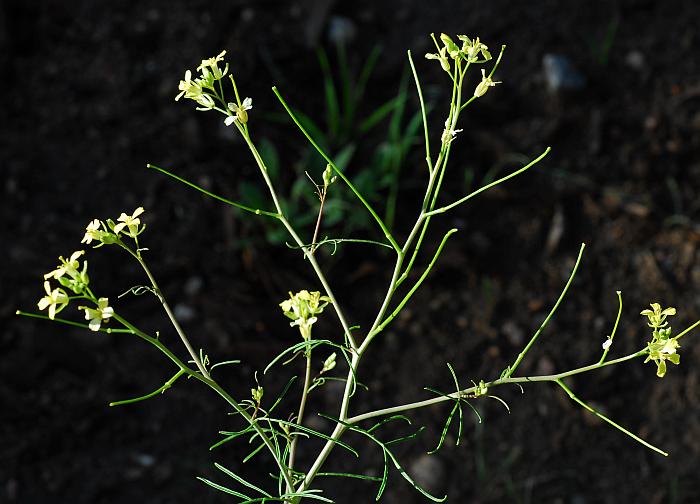Sisymbrium altissimum L.
Tumble Mustard

Introduced
CC = *
CW = 3
MOC = 24
© SRTurner
Sisymbrium altissimum L.Tumble Mustard | |
 |
Introduced CC = * CW = 3 MOC = 24 |
© SRTurner |
|
Family - Brassicaceae Habit - Taprooted annual forb. Stems - Ascending to erect, to 1.2 m, branching in he apical third, usually hispid near the base, becoming sparsely hairy to glabrous above, slightly angled from decurrent petiole tissue.
Leaves - Alternate, petiolate, 2-40 cm long, lanceolate to oblanceolate in outline, pinnately lobed or divided into 7-17 lobes, these entire to lobed, those of the lowermost leaves more numerous and lanceolate, often involute, 1.0-1.5 cm long, 5 mm broad, hairy, those of the uppermost leaves fewer and narrowly linear, glabrous.
Inflorescence - Terminal and lateral racemes to 15cm long, compact in flower, elongating quickly in fruit, axis glabrous. Pedicels 7-8 mm long in flower, to 1 cm long and stout in fruit, glabrous.
Flowers - Sepals 4, 4-6 mm long, spreading to erect, linear, glabrous, rounded and scarious at the apex, green. Petals 4, 6-8 mm long, spreading in the apical 1/2, white to yellow, spatulate, rounded at the apex, glabrous, tapering to a clawed base. Stamens 6 (4 larger, 2 smaller), erect, exserted. Filaments to 5 mm long, glabrous, translucent-white. Anthers 2 mm long, erect and then spreading at dehiscence. Ovary cylindric, green, glabrous, to 6 mm long in flower, superior, erect. Style 0.5-2.0 mm long at fruiting. Stigma capitate, two-lobed, 1.1 mm broad.
Fruits - Siliques 6-9 cm long, spreading to loosely ascending at maturity, not appressed to the inflorescence axis, glabrous, the stalk relatively stout, about as wide as the fruit. Seeds 90-120 per fruit, 0.8-1.0 mm long. Flowering - April - August. Habitat - Fields, pastures, roadsides, railroads, sandy and rocky open ground. Origin - Native to Europe. Lookalikes - Broadly, S. loeselii; species of Brassica. Other info. - This species is somewhat uncommon in Missouri, found in scattered locations which lack a well-defined geographic preference within the state. It is far more common in western regions of the country. It is recognized by its tall, gangly, weedy appearance, filiform divisions of the upper leaves, and long fruits which are ascending but not appressed to the inflorescence axis. The flowers vary in color from yellow to white but are most commonly pale yellow. Photographs taken at Eagle Bluffs Conservation Area, Boone County, MO., 5-3-04 (DETenaglia); also in Rocky Mountain National Park, Larimer County, CO, 7-31-2017 and 7-5-2019 (SRTurner). |